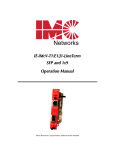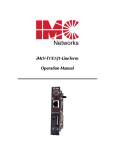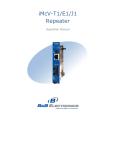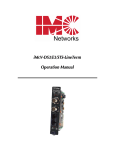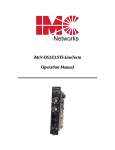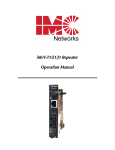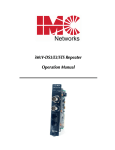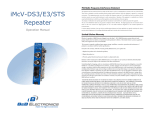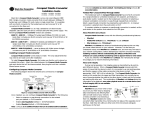Download IMC Networks iMcV-T1/E1/J1-LineTerm
Transcript
iMcV-T1/E1/J1-LineTerm Operation Manual FCC Radio Frequency Interference Statement This equipment has been tested and found to comply with the limits for a Class A computing device, pursuant to Part 15 of the FCC Rules. These limits are designed to provide reasonable protection against harmful interference when the equipment is operated in a commercial environment. This equipment generates, uses and can radiate radio frequency energy and, if not installed and used in accordance with the instruction manual, may cause harmful interference to radio communications. Operation of this equipment in a residential area is likely to cause harmful interference in which the user will be required to correct the interference at his own expense. Any changes or modifications not expressly approved by the manufacturer could void the user’s authority to operate the equipment. The use of non-shielded I/O cables may not guarantee compliance with FCC RFI limits. This digital apparatus does not exceed the Class BAlimits for radio noise emission from digital apparatus set out in the Radio Interference Regulation of the Canadian Department of Communications. Le présent appareil numérique n’émet pas de bruits radioélectriques dépassant les limites applicables aux appareils numériques de classe A prescrites dans le Règlement sur le brouillage radioélectrique publié par le ministère des Communications du Canada. Warranty IMC Networks warrants to the original end-user purchaser that this product, EXCLUSIVE OF SOFTWARE, shall be free from defects in materials and workmanship under normal and proper use in accordance with IMC Networks' instructions and directions for a period of six (6) years after the original date of purchase. This warranty is subject to the limitations set forth below. At its option, IMC Networks will repair or replace at no charge the product which proves to be defective within such warranty period. This limited warranty shall not apply if the IMC Networks product has been damaged by unreasonable use, accident, negligence, service or modification by anyone other than an authorized IMC Networks Service Technician or by any other causes unrelated to defective materials or workmanship. Any replaced or repaired products or parts carry a ninety (90) day warranty or the remainder of the initial warranty period, whichever is longer. To receive in-warranty service, the defective product must be received at IMC Networks no later than the end of the warranty period. The product must be accompanied by proof of purchase, satisfactory to IMC Networks, denoting product serial number and purchase date, a written description of the defect and a Return Merchandise Authorization (RMA) number issued by IMC Networks. No products will be accepted by IMC Networks which do not have an RMA number. For an RMA number, contact IMC Networks at PHONE: (800) 624-1070 (in the U.S. and Canada) or (949) 465-3000 or FAX: (949) 465-3020. The end-user shall return the defective product to IMC Networks, freight, customs and handling charges prepaid. End-user agrees to accept all liability for loss of or damages to the returned product during shipment. IMC Networks shall repair or replace the returned product, at its option, and return the repaired or new product to the end-user, freight prepaid, via method to be determined by IMC Networks. IMC Networks shall not be liable for any costs of procurement of substitute goods, loss of profits, or any incidental, consequential, and/or special damages of any kind resulting from a breach of any applicable express or implied warranty, breach of any obligation arising from breach of warranty, or otherwise with respect to the manufacture and sale of any IMC Networks product, whether or not IMC Networks has been advised of the possibility of such loss or damage. EXCEPT FOR THE EXPRESS WARRANTY SET FORTH ABOVE, IMC NETWORKS MAKES NO OTHER WARRANTIES, WHETHER EXPRESS OR IMPLIED, WITH RESPECT TO THIS IMC NETWORKS PRODUCT, INCLUDING WITHOUT LIMITATION ANY SOFTWARE ASSOCIATED OR INCLUDED. IMC NETWORKS SHALL DISREGARD AND NOT BE BOUND BY ANY REPRESENTATIONS OR WARRANTIES MADE BY ANY OTHER PERSON, INCLUDING EMPLOYEES, DISTRIBUTORS, RESELLERS OR DEALERS OF IMC NETWORKS, WHICH ARE INCONSISTENT WITH THE WARRANTY SET FORTH ABOVE. ALL IMPLIED WARRANTIES INCLUDING THOSE OF MERCHANTABILITY AND FITNESS FOR A PARTICULAR PURPOSE ARE HEREBY LIMITED TO THE DURATION OF THE EXPRESS WARRANTY STATED ABOVE. Every reasonable effort has been made to ensure that IMC Networks product manuals and promotional materials accurately describe IMC Networks product specifications and capabilities at the time of publication. However, because of ongoing improvements and updating of IMC Networks products, IMC Networks cannot guarantee the accuracy of printed materials after the date of publication and disclaims liability for changes, errors or omissions. ii Table of Contents FCC Radio Frequency Interference Statement.................................................... ii Warranty ........................................................................................................... ii About the iMcV-T1/E1/J1-LineTerm ................................................................... 1 Installation......................................................................................................... 1 Configuration .................................................................................................... 1 Prerequisites...................................................................................................... 2 Managed Modules............................................................................................. 3 Unmanaged Modules ........................................................................................ 4 DIP Switches ..................................................................................................... 4 DIP Switch Settings (S2, S3) ............................................................................... 5 Features ............................................................................................................ 6 LED Operation .................................................................................................. 9 Loopback Testing ............................................................................................ 10 Pseudorandom Bit Sequence (PRBS) Testing.................................................... 11 Installation Troubleshooting............................................................................. 12 Specifications .................................................................................................. 14 IMC Networks Technical Support .................................................................... 14 Fiber Optic Cleaning Guidelines...................................................................... 15 Electrostatic Discharge Precautions .................................................................. 15 Safety Certifications ......................................................................................... 17 iii About the iMcV-T1/E1/J1-LineTerm iMcV-T1/E1/J1-LineTerm is an SNMP-Manageable module that convert standard TDM-based copper transports ( T1, E1, J1) to a single-mode or multi-mode fiber signal. It performs a standard “Line Termination” function as defined in GR-820CORE. This function transmits an Alarm Indication Signal (AIS) on the line whenever the received signal is lost. Line faults can easily be isolated to one line section and do not propagate over multiple-line sections as they do with normal line repeaters. Each module includes one RJ-48 connector and one pair of ST or SC fiber optic connectors. These modules can be installed in any iMediaChassis but can only be managed through the iMediaChassis. The iMcV-T1/E1/J1-LineTerm modules must be deployed in pairs (one at each end of a fiber line). The data transmitted on the fiber ports can only be received and interpreted by another iMcV-T1/E1/J1LineTerm unit. The iMcV-T1/E1/J1-LineTerm is also available with single-strand fiber allowing two wavelengths (1310 nm and 1550 nm) to share one fiber strand, essentially doubling the capacity of installed fiber. With the single-strand version, the HOST and REMOTE must be ordered with opposite transmit and receive wavelengths for proper operation. Installation The iMcV-T1/E1/J1-LineTerm modules can be installed in any iMediaChassis series. Each module requires one slot in the chassis. To install a module, remove the blank brackets covering the slots where the module is to be installed by removing the screws on the outside edges of the bracket. Slide the module into the chassis card guides until the module is securely seated in the connector. Secure the module to the chassis by tightening the captive screw. Save any blanks removed during installation for future use. Crossover/Straight-Through Connection iMcV-T1/E1/J1-LineTerm comes with an RJ-48 UTP connector that features a push-button switch, located next to the port, for selecting a crossover connection, push-button IN. A straight-through connection is selected when the push-button is OUT. When unsure what type of connection is needed, set the push button to the position that turns the LOS LED off. Configuration Proper configuration of the iMcV-T1/E1/J1-LineTerm is required for maximum performance and reliability. The following sections describe the prerequisites and the configurations available for both managed and unmanaged modules. 1 Prerequisites The iMcV-T1/E1/J1-LineTerm conforms to any T1/E1/J1-based environment. Ensure all of the relevant information about the expected installation environment is available before configuring the module. This information includes: • • • • • • • Line Type T1 or E1 Line Coding used on T1: either AMI or B8ZS Distance of the copper run for DSX1 lines (655 feet MAX) Required CSU line Buildout (0db to -22db) Receiver BOOST for T1 and E1 applications Fiber transceivers must be for appropriate fiber run, i.e. (SM or MM) Management location must be at HOST unit 2 Managed Modules The iMcV-T1/E1/J1-LineTerm modules are installed as a HOST-REMOTE pair and can be remotely managed when the HOST is installed in an iMediaChassis with an SNMP Management module. For a managed environment, first manually configure the desired features through DIP Switch settings to ensure this configuration is maintained if management is ever lost. After the module is installed, the SNMP enabled features for troubleshooting can be modified by using the included iView2 SNMP management software. In a managed chassis, the software settings take priority over DIP Switch settings. Ensure the software settings match the desired configuration requirements for the installation as the chassis may maintain an old setting from a previous installation for that slot location. iView² Management Software iView² is the IMC Networks management software designed specifically for the IMC Networks “iMcV” family of modules. It features a GUI and gives network managers the ability to monitor and control the manageable IMC Networks products. iView² is available in several versions and can also function as a snap-in module for HP OpenView Network Node Manager and other third party SNMP Management software. For assistance in selecting the right version of iView² for your operating system, please visit: http://www.imcnetworks.com/products/iview2.cfm iView2 supports the following platforms: • • • • Windows NT Windows 2000 Windows XP Windows Vista In addition, there are Java versions of iView² for any Java-capable operating systems such as Linux. Please see the SNMP Management Module for software configuration options. 3 Unmanaged Modules Before installing the module in an unmanaged chassis, manually configure all of the desired DIP Switch selectable features. Modules must be configured as a HOST-REMOTE pair via DIP Switches. Modules are shipped in the default setting as a HOST. HOST: S3-2 OFF REMOTE: S3-2 ON DIP Switches The iMcV-T1/E1/J1-LineTerm DIP Switches are located on S2 and S3 on the PCB. The location of the S2 and S3 DIP Switches are displayed in the following diagram: 4 DIP Switch Settings (S2, S3) Switch Settings for Switch S2 T1/E1 Selection S2-1: OFF S2-1: ON T1 Mode Selected E1 Mode Selected default Receive Equalizer Gain Limit (EGL) iVIEW2 iVIEW2 iVIEW2 iVIEW2 iVIEW2 iVIEW2 E1 S2-2: ON -12 dB (Short Haul) S2-2: OFF -43 dB (Long Haul) T1 S2-2: ON -36 dB (Long Haul) S2-2: OFF -30 dB (Limited Long Haul) default iVIEW2 Line Encoding iVIEW2 S2-3: ON HDB3 (E1) / B8ZS (T1) S2-3: OFF AMI (Required for Passive Mode) iVIEW2 iVIEW2 default Transmit LIU Waveshape (Build-out) SWITCH S2 E1 S2-4: ON S2-4: OFF S2-4: ON S2-4: OFF S2-5: ON S2-5: ON S2-5: ON S2-5: ON S2-6: ON S2-6: ON S2-6: OFF S2-6: OFF 75 ohms 125 ohms 75 S ohms w/ High Return Loss 125 S ohms w/ High Return Loss S2-4: ON S2-4: OFF S2-4: ON S2-4: OFF S2-4: ON S2-4: OFF S2-4: ON S2-4: OFF S2-5: ON S2-5: ON S2-5: OFF S2-5: OFF S2-5: ON S2-5: ON S2-5: OFF S2-5: OFF S2-6: ON S2-6: ON S2-6: ON S2-6: ON S2-6: OFF S2-6: OFF S2-6: OFF S2-6: OFF DSX-1 (0 to 133 ft) 0 dB CSU DSX-1 (133 to 266 ft) DSX-1 (266 to 399 ft) DSX-1 (399 to 533 ft) DSX-1 (533 to 655 ft) -7.5 dB CSU -15 dB CSU -22.5 dB CSU T1 default Receive LIU Termination S2-7: ON S2-7: OFF S2-7: ON S2-7: OFF S2-8: ON S2-8: ON S2-8: OFF S2-8: OFF Receive Side Termination Disabled Receive Side 120 ohms Enabled Receive Side 100 ohms Enabled Receive Side 75 ohms Enabled default Transmit Data Source iVIEW2 S2-9: ON S2-9: OFF S2-9: ON S2-9: OFF S2-10: ON S2-10: ON S2-10: OFF S2-10: OFF Standard Data Transmit Pseudorandom Bit Sequence (PRBS) Transmit Alternating Ones and Zeros Transmit Unframed All Ones 5 iVIEW2 iVIEW2 iVIEW2 iVIEW2 default Switch Settings for Switch S3 Jitter Attenuator Select S3-1: ON S3-1: OFF Place Jitter Attenuator on RCV Side Place Jitter Attenuator on XMT Side default Remote Management S3-2: ON S3-2: OFF Remote Management Enabled (only at the REMOTE end) Remote Management Disabled (only at the LOCAL end) default SWITCH S3 Loopback Selection iVIEW2 S3-3: ON S3-3: OFF S3-3: ON S3-3: OFF S3-4: ON S3-4: ON S3-4: OFF S3-4: OFF None Local Loopback Analog Loopback Remote Loopback iVIEW2 iVIEW2 iVIEW2 iVIEW2 default Monitor/Boost Mode S3-5: ON S3-5: OFF S3-5: ON S3-5: OFF S3-6: ON S3-6 ON S3-6 OFF S3-6 OFF Normal Operation (No Boost) 20 dB 26 dB 32 dB default NRZ Selection iVIEW2 S3-7: ON S3-7: OFF Disable NRZ (Required for Passive Mode) Enable NRZ (Line Terminating Mode) iVIEW2 iVIEW2 default Fiber Type S3-8: Factory Configured S3-9: Factory Configured S3-10: Factory Configured DO NOT CHANGE DO NOT CHANGE DO NOT CHANGE Features The iMcV-T1/E1/J1-LineTerm module includes several features to facilitate maintenance and troubleshooting in any T1/E1/J1 based TDM environment. Loopback Modes This feature allows three distinct Loopbacks to be activated either through DIP Switches or iView2 Management. It is recommended to only enable Loopbacks through management to insure normal operation if management is ever lost. Fiber Loopback An analog Loopback at the copper port back to the fiber port. It copies the received optical signal back to the optical line at the copper port and continues to drive the copper port, ignoring all errors incoming on the copper port. Internal Fiber Loopback A local Loopback at the fiber port. It copies the received optical signal back to the optical line at a digital point internal to the unit. It continues to drive the copper port, and normal copper line monitoring is maintained on the copper port. Copper Loopback A remote Loopback to copper port at the fiber driver. It copies the received copper signal back to the copper port and continues to drive the fiber port. 6 By default all Loopbacks are set to OFF for normal data operation. This feature can be controlled by SNMP–Management software (iView2) when the HOST iMcV-T1/E1/J1-LineTerm module is installed in a managed chassis. Fault Loopback This switch enables or disables the Fault Loopback feature on the copper port. A normal copper line fault LOS will cause Remote Alarm Indictor (RAI) to be sent on to the fiber line segment causing the normal AIS to be sent on the far end copper port. This feature provides for a fault indication to be sent back to the copper line as an AIS signal. In this way, both upstream and downstream personnel are alerted to a copper cable fault. The Fault Loopback feature is always active on the fiber line. When a fiber line becomes unavailable, the module detects the LOS on the fiber link and lights the LOS LED. The module then sends AIS to the local copper port and sends a RAI signal back to the fiber. The far end unit turns ON the RAI LED and outputs AIS to the far end copper line. With this, a local site administrator can quickly determine where a fiber fault is located from either end of the fiber line. The AIS is transmitted as an unframed all ones pattern on the copper port. By default this feature is Enabled. This feature can be controlled by SNMP-Management software (iView2) when the HOST iMcV-T1/E1/J1-LineTerm module is installed in a managed chassis. Transmit LIU Waveshape and Gain (Line Build-Out) This group of switches can be configured for the length of line the unit is driving, from 0 feet to a maximum of 655 feet. For longer length lines, the unit can be configured for CSU signal gain to address -7.5 db, -15db, and -22.5 db degraded signals. By default this feature is set to 0 to 255 FEET line Buildout for DSX1 lines. Transmit Data Source These switches select the transmit mode used by the iMcV-T1/E1/J1-LineTerm module. The transmit modes that can be selected include the following: • • • • Standard data Unframed All Ones (diagnostic) Alternating Ones and Zeros (diagnostic) Pseudorandom Bit Sequence (diagnostic 220-1 PRBS Pattern) 7 These standard Telco transmission pattern modes are provided to help diagnose transmission errors in the line. By default this feature is set to Standard Data. This feature can be controlled by SNMP-Management software (iView2) when the HOST iMcV-T1/E1/J1-LineTerm module is installed in a managed chassis. T1, E1 and J1 Selection This switch selects the data rate to use on the copper line. The data rate selections available include the following: • • T1/J1 (1.544 Mbps +/- 32 ppm) E1 (2.048 Mbps +/- 32 ppm) By default this feature is set to T1. This feature can be selected only by setting the DIP Switches manually. Remote Management A DIP Switch enables or disables the Remote Management mode. By default this feature is Disabled. Remote Management must be enabled on the REMOTE module. This allows all SNMP-configurable features for the REMOTE modules to be configured from the HOST module. 8 LED Operation The iMcV-T1/E1/J1-LineTerm module features several diagnostic LEDs per port. The following LED display functions are provided: Copper Port LEDs ER LOS PRBS TEST Flashes yellow whenever a line code violation is received. Glows red when the RJ-48 is receiving no signal and is in an LOS ALARM state. This condition will also send an RAI signal to the fiber port. If the Fault Loopback is set to ON, an AIS will also be sent to the local copper port. Glows green when the copper port receives a valid Pseudorandom Bit Sequence (PRBS). It is OFF when the port is not receiving a PRBS. Glows yellow when any Loopback mode is active. Fiber Port LEDs ER LOS RM RAI Glows yellow when a fiber symbol error has been received. Glows red when a fiber link is not established and is in a LOS ALARM state. Glows green on the REMOTE unit when Remote Management is enabled. Glows green on the HOST unit when it has discovered a manageable REMOTE unit. Under normal operation this LED is the only LED that is ON at the unit. Glows yellow when a Remote Alarm Indication (RAI) is received on the fiber port. This indicates a fault exists at the far end unit. 9 Loopback Testing The iMcV-T1/E1/J1-LineTerm includes three Loopback test modes: Copper Loopback, Fiber Loopback and Internal Fiber Loopback. The following illustrations show the path that a signal takes in each of the Loopback test modes. Each Loopback performs the following: • Copies the incoming signal back out to the origin while continuing to transmit this signal downstream. • Blocks upstream data from transmitting on the looped data line. Loopback testing is useful for troubleshooting problems with network connections should they occur. Looping received data back onto the transmit path helps determine whether a connection is still valid. Copper Loopback tests isolate problems on the copper run between an iMcV-T1/E1/J1-LineTerm module and the connected device, while Fiber Loopback tests can isolate problems on the fiber connected to the module. The following illustrations show a typical progression of Loopback tests (i.e., starting by checking the copper segment at the local side, then the fiber segment at the REMOTE side, etc). 10 Copper Loopback on Host iMcV-T1/E1/J1-LineTerm Central Office Copper Loopback Copper None Fiber Copper Customer Remote Host X iMcV-T1/E1/J1-LineTerm iMcV-T1/E1/J1-LineTerm Fiber Loopback on Remote iMcV-T1/E1/J1-LineTerm Central Office Copper None Fiber Fiber Loopback Copper Customer Remote Host X iMcV-T1/E1/J1-LineTerm iMcV-T1/E1/J1-LineTerm Pseudorandom Bit Sequence (PRBS) Testing To test using PRBS, configure the iMcV-T1/E1/J1-LineTerm modules for No Loopback, and then configure the Transmit Copper Data Source to PRBS. Configure the local device for Loopback and start the test. Verify the PRBS LED is ON indicating no errors are being received. Central Copper Pseudo Random Bit Sequence PRBS LED PRBS Office Copper Fiber X PRBS LED iMcV-T1/E1/J1-LineTerm iMcV-T1/E1/J1-LineTerm Remote Host 11 Customer Installation Troubleshooting General Troubleshooting • The copper port can easily be tested using the internal PRBS signal generator and detector and a physical wire loop on the copper interface. • The fiber port is internally tested at all times by a working pair of units. With one unit configured for Local Management (S3-2 set OFF) and the other for Remote Management (S3-2 set ON), the fiber line is verified if the RM LED is ON at both ends of the fiber line. Under normal operation only the RM LED is ON at both HOST and REMOTE. • To test a media converter by itself, first verify that the fiber patch cable is appropriate, then follow these steps to test: 1. Connect the media converter to the RJ-48 device with a copper cable. 2. Loop a single strand of fiber from the transmit port to the receive port of the media converter. 3. Verify that there is a valid connection for both the RJ-48 and fiber ports on the media converter. (No ER or LOS LED ON) • If there is trouble with link connectivity, verify that the cable connection and DIP Switch settings are correct. ER LOS PRBS TEST ER LOS PRBS TEST Use the following LED indications to identify the fault location: COAX COAX Copper Fault LOS X AIS RAI * AIS FIBER ER LOS RM RAI ER LOS RM RAI FIBER iMcV-T1/E1/J1-LineTerm COAX ER LOS PRBS TEST iMcV-T1/E1/J1-LineTerm iMcV-T1/E1/J1-LineTerm ER LOS PRBS TEST iMcV-T1/E1/J1-LineTerm COAX LOS Fiber Fault AIS X RAI AIS FIBER ER LOS RM RAI ER LOS RM RAI FIBER *DIP Switch S3-7 must be set to ON for Fault Loopback to operate as illustrated. 12 The following table lists the pin configuration for the RJ-48 connector. Pin 1 2 3 4 5 6 7 8 Signal Receive Ring Receive Tip No Connection Transmit Ring Transmit Tip No Connection No Connection No Connection Pin 1 13 Specifications Standards Compliance (T1, E1, J1): ANSI T1.102-1993 ANSI T1.107.1995 GR-820-CORE T1, E1, J1 Interface: T1 (1.544 Mbps +/- 32 ppm) E1 (2.048 Mbps +/- 32 ppm) J1 (1.544 Mbps +/- 32 ppm) Power Consumption (Typical): 0.550 Amps @ 5 V Operating Temperature: +32°F to +122°F (0°C to +50°C) Storage Temperature: -4°F to +158°F (-20°C to +70°C) Humidity: 5 to 95% (non-condensing); 0 to 10,000 ft. altitude Dimensions: Single Slot iMcV module IMC Networks Technical Support Tel: (949) 465-3000 or (800) 624-1070 (in the U.S. and Canada); +32-16-550880 (Europe) Fax: (949) 465-3020 E-Mail: [email protected] Web: www.imcnetworks.com 14 Fiber Optic Cleaning Guidelines Fiber Optic transmitters and receivers are extremely susceptible to contamination by particles of dirt or dust, which can obstruct the optic path and cause performance degradation. Good system performance requires clean optics and connector ferrules. 1. Use fiber patch cords (or connectors, if you terminate your own fiber) only from a reputable supplier; low-quality components can cause many hard-todiagnose problems in an installation. 2. Dust caps are installed at IMC Networks to ensure factory-clean optical devices. These protective caps should not be removed until the moment of connecting the fiber cable to the device. Should it be necessary to disconnect the fiber device, reinstall the protective dust caps. 3. Store spare caps in a dust-free environment such as a sealed plastic bag or box so that when reinstalled they do not introduce any contamination to the optics. 4. If you suspect that the optics have been contaminated, alternate between blasting with clean, dry, compressed air and flushing with methanol to remove particles of dirt. Electrostatic Discharge Precautions Electrostatic discharge (ESD) can cause damage to any product, add-in modules or stand alone units, containing electronic components. Always observe the following precautions when installing or handling these kinds of products 1. Do not remove unit from its protective packaging until ready to install. 2. Wear an ESD wrist grounding strap before handling any module or component. If the wrist strap is not available, maintain grounded contact with the system unit throughout any procedure requiring ESD protection. 3. Hold the units by the edges; do not touch the electronic components or gold connectors. 4. After removal, always place the boards on a grounded, static-free surface, ESD pad or in a proper ESD bag. Do not slide the modules or stand alone units over any surface. 15 WARNING! Integrated circuits and fiber optic components are extremely susceptible to electrostatic discharge damage. Do not handle these components directly unless you are a qualified service technician and use tools and techniques that conform to accepted industry practices. 16 Safety Certifications UL/CUL: Listed to Safety of Information Technology Equipment, including Electrical Business Equipment. CE: The products described herein comply with the Council Directive on Electromagnetic Compatibility (2004/108/EC) and the Council Directive on Electrical Equipment Designed for use within Certain Voltage Limits (2006/95/EC). Conforms to UL Std. 60950-1; Certified to CSA Std. C22.2 No. 60950-1 3178738 Class 1 Laser product, Luokan 1 Laserlaite, Laser Klasse 1, Appareil A’Laser de Classe 1 European Directive 2002/96/EC (WEEE) requires that any equipment that bears this symbol on product or packaging must not be disposed of with unsorted municipal waste. This symbol indicates that the equipment should be disposed of separately from regular household waste. It is the consumer’s responsibility to dispose of this and all equipment so marked through designated collection facilities appointed by government or local authorities. Following these steps through proper disposal and recycling will help prevent potential negative consequences to the environment and human health. For more detailed information about proper disposal, please contact local authorities, waste disposal services, or the point of purchase for this equipment. 17 19772 Pauling • Foothill Ranch, CA 92610-2611 USA TEL: (949) 465-3000 • FAX: (949) 465-3020 www.imcnetworks.com © 2010 IMC Networks. All rights reserved. The information in this document is subject to change without notice. IMC Networks assumes no responsibility for any errors that may appear in this document. iMcV-T1/E1/J1-LineTerm is a trademark of IMC Networks. Other brands or product names may be trademarks and are the property of their respective companies. Document Number 50-80103-00 A4 July 2010





















